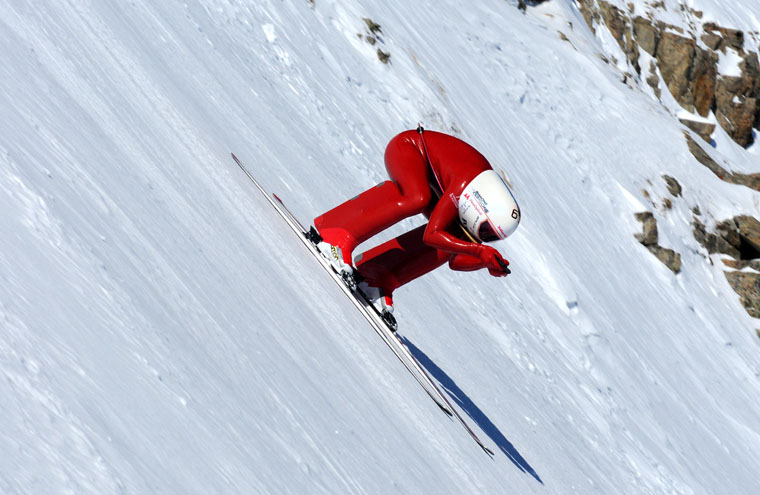The science of speed


The action sports film company Teton Gravity Research was named with a tongue-in-cheek reference to a particularly rocky range of the Rocky Mountains known as the Tetons. If dropping cliffs in Wyoming makes you a gravity researcher, by that reasoning what does racing downhill at 90mph make you, and how much do downhill racers actually understand about the science of speed?
Skiing is about playing with forces: gravity, the centripetal force exerted in a turn or kicker, the frictional drag between skis and snow, and the aerodynamic drag of air resistance. Ski racers may not fully understand the science behind their sport, but through years of training they have gained an intuitive knowledge of what will make them go fast.
When I was coaching the U16 GB squad, I set an experiment to see how much the young racers understood about line and speed. On a wide-open piste, I set two points diagonally across the slope and asked two skiers at a time to traverse across. One skier was to take the straight line from A to B, while the other skier would start off in the fall-line and make a turn towards point B.
Most worked out immediately that the shortest straight route would not be the fastest. The racers who were asked to ski from the fall-line made their own calculations as to when to turn across the slope once on the move, subconsciously basing their decisions on: their mass relative to the steepest of the slope, the radius of their skis, and how aerodynamic they deemed their clothing. Interestingly when we repeated the experiment, almost all had picked their fastest line at the first time of asking.

Top-class ski racers know that race time equals distance divided by speed; mid race they make split second calculations as to when to opt for more speed or less distance. In slalom and GS, skiing a rounder line increases the distance, but that can be outweighed by a cleaner carve and a faster traveling ski. In the wider radius turns of the speed events, line choice is paramount. Whereas in the technical disciplines line variation is measured in centimetres, in downhill, racers’ lines can diverge by up to 10 metres in some sections.
When it comes to the physical build of a downhill racer, big is better. The gravity of Earth is a constant 1g, ignoring the slight variances for altitude and latitude, so a feather or a ton of lead dropped in a vacuum would both accelerate at 9.8 metres per second squared. Fortunately we do not live in a vacuum, our planet has an atmosphere that gives us air, water and most importantly snow.
Given that most ski racers are equally dense, (no pun intended), with similar muscle to fat percentages, a bigger racer will have proportionally more mass for their surface area. Extra mass gives increased momentum, which fights against both the aerodynamic drag and the frictional drag from the skis. Traditionally downhill racers spent more time in the gym bulking up with heavy lifting weights, than technical skiers.
In the quest for speed, extra weight is not the only answer, especially as the speed increases. A good personal example was when I tried my hand at speed skiing. Competitions begin using a low start point, working up the track with every run, so gradually increasing the speeds. At lower speeds I happily recorded faster speeds than the top female competitors who weighed about 30kg less than me.
I did not account for the fact that drag increases with a square of the speed, so twice the speed equals four times the drag. At 120mph their better drag coefficient kicked in and they subsequently kicked my arse. At really high speeds aerodynamic drag is the biggest factor, so body shape is all-important. Unlike the bulky downhiller, the best speed skiers are tall and thin. Many hours are spent in wind tunnels looking for ways of reducing drag. A long back in comparison to their legs will help them fold into a perfect tuck: legs wide, a flat back, and elbows in front of knees.
I admit that the average downhill racer or speed skier would not be able to write a thesis on aerodynamics, but although they may not understand the science of speed, they certainly know how to apply it.